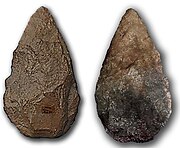
Back Paleolitikum Afrikaans Altsteinzeit ALS العصر الحجري القديم Arabic Paleolíticu AST Paleolit Azerbaijani Палеолит Bashkir Oidstoazeit BAR Senuojė kūlė gadīnė BAT-SMG Paleolitiko BCL Палеаліт Byelorussian



The Palaeolithic (or Paleolithic)[1] was a period of prehistory when humans made stone tools. It was the first and longest part of the Stone Age. It began around 3.3 million years ago and ended around 11,650 years ago.[2] About 99% of human history happened in the Palaeolithic.[3]
The Palaeolithic began when hominids (early humans) started to use stones as tools for bashing, cutting, and scraping. All members of the genus Homo made stone tools, starting with relatively crude tools made by Homo habilis and Homo erectus. In Europe, the large-brained Neanderthal Man (Homo neanderthalensis) made tools of high quality. Our own species, Homo sapiens, made even higher-quality tools. These tools are the first cultural products which have survived to modern times.[4][5]
The oldest stone tools ever found are about 3.3 million years old. Archaeologists found these tools in the Great Rift Valley of Africa.[6][7] Australopithecines probably made them. Archaeologists have found stone tools in continental Europe from about one million years ago, and in Britain from about 700,000 years ago.
During the Palaeolithic Age, humans grouped together in small bands. They lived by gathering plants and hunting wild animals.[8] They made tools out of wood and bone as well as stone. They probably also used leather and vegetable fibers, but these do not last as long as stone and have not survived to modern times.
The Palaeolithic ended around 11,650 years ago, when humans began to make smaller, finer tools. In Western Europe, this was the beginning of the Mesolithic period. In warmer climates like Africa, the Epipaleolithic period came after the Palaeolithic.[9][10][11]
The Pleistocene geological epoch (also called the Ice Age) happened at the same time as the Palaeolithic. In some areas, like Western Europe, this ice age affected the way people lived. In the Middle East, people began to switch from hunting and gathering to agriculture. Both the Palaeolithic and the Pliestocene ended around the same time.
- ↑ Ancient Greek: palaios = old; and lithos = stone. Coined by John Lubbock in 1865.
- ↑ Toth, Nicholas; Schick, Kathy (2007). "21 Overview of Paleolithic Archeology". In Henke, H. C. Winfried; Hardt, Thorolf; Tatersall, Ian (eds.). Handbook of Paleoanthropology. Vol. 3. Berlin; Heidelberg; New York: Springer. pp. 1943–1963. doi:10.1007/978-3-540-33761-4_64. ISBN 978-3-540-32474-4.
- ↑ Nicholas Toth and Kathy Schick (2007). Handbook of Paleoanthropology. Springer. p. 1963. 978-3-540-33761-4 (Online). Archived from the original on 2020-04-13. Retrieved 2008-04-11.
- ↑ Klein, Richard G. 2009. The human career: human biological and cultural origins. 3rd ed, Chicago.
- ↑ Hosfield R.T., Wenban-Smith F.F. & Pope M.I. 2009. Great prehistorians: 150 years of Palaeolithic research, 1859–2009. Lithics 30.
- ↑ Morelle, Rebecca 2015. Oldest stone tools pre-date earliest humans. BBC News Science & Environment. [1]
- ↑ Harmand, Sonia et al 2015. 3.3-million-year-old stone tools from Lomekwi 3, West Turkana, Kenya. Nature 521, 310–315. [2]
- ↑ McClellan (2006). Science and Technology in World History: An Introduction. Baltimore, Maryland: JHU Press. ISBN 0-8018-8360-1. Page 6-12
- ↑ Mesolithic Period. 2008. In Encyclopædia Britannica. Retrieved April 10, 2008, from Encyclopædia Britannica Online.
- ↑ "Stone Age," Microsoft® Encarta® Online Encyclopedia 2007 Archived 2009-10-29 at the Wayback Machine © 1997-2007 Microsoft Corporation. Contributed by Kathy Schick and Nicholas Toth
- ↑ Grolier Incorporated (1989). The Encyclopedia Americana. University of Michigan: Grolier Incorporated. p. 542. ISBN 0-7172-0120-1.